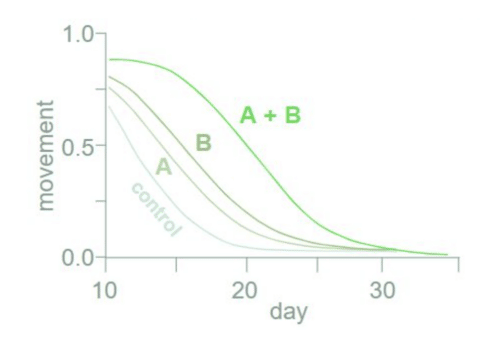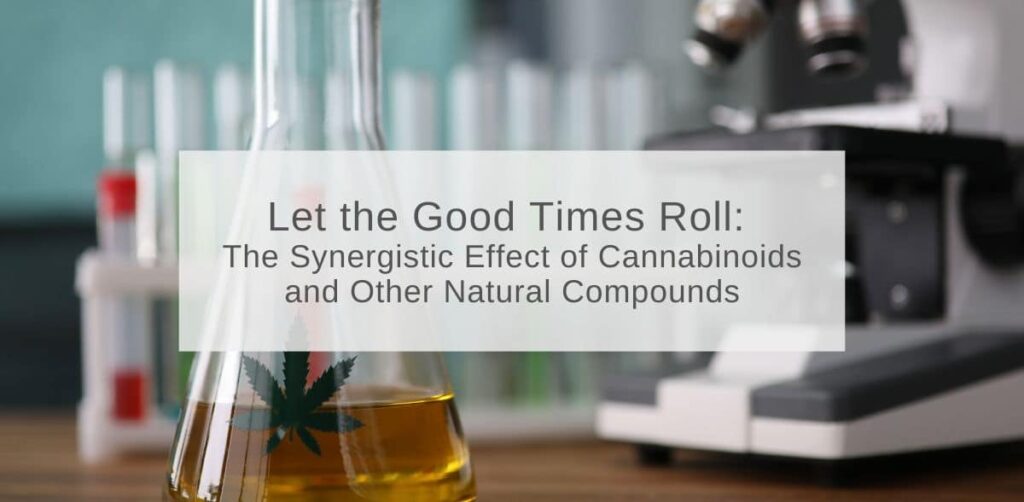Summary:
Natural products (bioactive compounds derived from natural resources, most predominantly plants) have been used in medicines, notably ayurvedic and chinese medicine, for centuries (Koparde, Doijad & Magdum, 2019). Increasingly, research has found scientific evidence to substantiate health benefits of naturally sourced compounds such as: combating inflammation, decreasing blood pressure, pain relief, and improved sleep and mood. Moreover, it has been found that sometimes two compounds taken together can cause an increased impact: a synergistic effect. In this article we will discuss natural compounds, their benefits, and the importance of research into synergistic blends.
Natural products can be defined as bioactive compounds that are derived from natural resources, most predominantly plants, and are used in pharmaceuticals and nutraceuticals to improve health, boost cognitive function, ease chronic pain, delay aging and support longevity (Koparde, Doijad & Magdum, 2019; Nasri, et al., 2014). While natural products have a long history in traditional medicines, and have been used in traditional drug discovery for decades, the skyrocketing nutraceutical market and the advent of new technologies which enable better research into these compounds have brought natural products back to the forefront.
In fact, the NIH has specifically called out the need for more research into natural products — recently publishing the National Center for Complementary and Integrative Health (NCCIH)’s 2021-2025 Strategic Plan which aims to study the “biological activities of natural products/interventions such as prebiotics, dietary supplements, botanicals, and vitamins (NIH, 2021). One of the Center’s top priorities is research into the “complex interactions involving nutritional interventions.” For example, evidence has been found that sometimes two compounds put together can cause an increased impact: a synergistic effect [Figure 1]. This is important both from a medical standpoint, helping optimize therapeutics, and from an industry side, as it emphasizes the importance of a company having a ‘proprietary blend’ of natural ingredients.

Figure 1. Evidence of Synergy (combine compounds A+B = higher activity).
This effect has been widely discussed in the cannabis industry, where it is referred to as the ‘entourage effect.’ The concept is this: when the cannabinoids CBD and THC (naturally occurring compounds in cannabis) are taken in conjunction they create a better, more well-rounded effect. This effect has implications in how CBD is used as a therapeutic: CBD products are currently being used to help manage pain and anxiety, reduce inflammation, and improve sleep (Coelho, 2021). There are two main types of CBD: full-spectrum CBD which leverages the entourage effect, and isolate CBD which contains only the one cannabinoid.
Full-spectrum:
In full-spectrum CBD most, or all, of the cannabinoids in the industrial cannabis plant are present. Full-spectrum CBD is often recommended for people who seek out CBD to address specific health problems as it has been found to leverage the entourage effect, and produce higher levels of relief in larger doses (unlike isolate). While full-spectrum CBD doesn’t contain enough THC (the main psychoactive compound in cannabis) to cause someone to feel ‘high’, some people such as professional athletes avoid full-spectrum CBD as the traces of THC can cause someone to fail a drug test.
Isolate:
In Isolate CBD, the CBD has been ‘isolated’ from nearly all other cannabinoids. Although Isolate CBD doesn’t benefit from the entourage effect, it is marketed as a THC-free option that still produces the desired effects of reduced anxiety and inflammation, pain relief, and immune boosting.

Figure 2. Google searches for “What is CBD”, from 2014-2019 (Google Trends).
Cannabis has grown exponentially in the marketplace over the last decade – there is a desire for better, more holistic, ‘supplements’ to improve human health [Figure 2]. It is important to ‘roll’ the entourage effect of cannabis into a broader conversation regarding synergy of natural compounds overall.
As previously mentioned, the increase in consumer demand and consumption of supplements has made it extremely profitable for companies to develop proprietary blends of natural compounds that exploit these synergistic effects. However, as we’ve discussed in other articles, this increase has also led to concern over the safety of supplement pills, particularly, when taken in conjunction with other supplements and medications, as antagonistic effects of natural compounds are also possible.
This being said, recent research into natural compounds has found that the synergistic effects of plant derivatives could be beneficial in the fight against cancers, inhibiting pandemics such as COVID-19, and speeding up the onset of antidepressants (Pezzani et al., 2019; Mishra et al., 2021; Zhang et al., 2022). Thus, maybe the future innovations in therapeutics won’t be the discovery of one compound or repurposed drug, but will be a result of combining compounds, bringing together plant derivatives to form a stronger, more effective blend. [Image 1].

Image 1. Promo photo for the TV show ‘Entourage’ (HBO).
Glossary
- Cannabinoid = naturally occurring compounds found in the Cannabis sativa plant (of the 480 compounds present in the plant only 66 of them are referred to as cannabinoids).
- Full-Spectrum CBD = most, or all, of the cannabinoids in the industrial cannabis plant are present.
- Natural products = bioactive compounds derived from natural resources, most predominantly plants
- Nutraceuticals = a foodstuff (such as a fortified food or dietary supplement) that provides health benefits in addition to its basic nutritional value” (Merriam-Webster, n.d.). Notably, the term originated from ‘nutrition’ and ‘pharmaceutical.’ In the industry, the term ‘Nutraceutical’ is often used rather than ‘dietary supplement’, as a way of specifying that the product is related to health span or lifespan. However, the FDA does not use the term ‘nutraceutical’ in their guidelines, instead, they are food additives that are GRAS (Generally Recognized as Safe). And, is considered to fall under the category of ‘supplements.’
- Examples: herbs and teas such as ginseng, green tea, echinacea, turmeric and garlic. Supplements such as vitamin D, B12, omega-3, folic acid, and minerals like calcium and iron. Other common ones include: fish oils, caffeine and probiotics.
- Isolate CBD = nearly 100% CBD (‘isolated from other cann
- Pharmaceuticals / Drugs = A substance intended for use in the diagnosis, cure, mitigation, treatment, or prevention of disease, or more broadly: a substance (other than food) intended to affect the structure or any function of the body
- Examples: pain relievers such as Tylenol, and Advil. Allergy relief pills like Benadryl, and Zyrtec. As well as, anti-seizure meds, birth control pills, antidepressants, and heart medications.
References
- Atanasov, A.G., Zotchev, S.B., Dirsch, V.M. et al. Natural products in drug discovery: advances and opportunities. Nat Rev Drug Discov 20, 200–216 (2021). https://doi.org/10.1038/s41573-020-00114-z
- Durazzo, A., Lucarini, M., & Santini, A. (2020). Nutraceuticals in Human Health. Foods, 9(3), 370. MDPI AG. Retrieved from http://dx.doi.org/10.3390/foods9030370
- Kim, J. (2020). The Powerful Benefits of Nutraceuticals on your Overall Health, https://jbkwellnesslabs.com/blog/the-powerful-benefits-of-nutraceuticals-on-your-overall-health/
- Nasri, H., Baradaran, A., Shirzad, H., & Rafieian-Kopaei, M. (2014). New concepts in nutraceuticals as alternatives for pharmaceuticals. International journal of preventive medicine, 5(12), 1487–1499.
- NIH (2021). Natural Products Research—Information for Researchers. National Center for Complementary and Integrative Health. https://www.nccih.nih.gov/grants/natural-products-research-information-for-researchers
- Mandal, A. (2019). What are Cannabinoids? News-Medical.Net, https://www.news-medical.net/health/What-are-Cannabinoids.aspx#:~:text=Cannabinoids%20are%20naturally%20occurring%20compounds,main%20psychoactive%20ingredient%20in%20cannabis.
- Pezzani, R., Salehi, B., Vitalini, S., Iriti, M., Zuñiga, F. A., Sharifi-Rad, J., Martorell, M., & Martins, N. (2019). Synergistic Effects of Plant Derivatives and Conventional Chemotherapeutic Agents: An Update on the Cancer Perspective. Medicina (Kaunas, Lithuania), 55(4), 110. https://doi.org/10.3390/medicina55040110
- Mishra, A., Khan, W. H., & Rathore, A. S. (2021). Synergistic Effects of Natural Compounds Toward Inhibition of SARS-CoV-2 3CL Protease. Journal of chemical information and modeling, 61(11), 5708–5718. https://doi.org/10.1021/acs.jcim.1c00994
- Zhang, H., Sun, Y., Yau, S. Y., Zhou, Y., Song, X., Zhang, H. T., Zhu, B., Wu, H., & Chen, G. (2022). Synergistic effects of two naturally occurring iridoids in eliciting a rapid antidepressant action by up-regulating hippocampal PACAP signalling. British journal of pharmacology, 10.1111/bph.15847. Advance online publication. https://doi.org/10.1111/bph.15847



